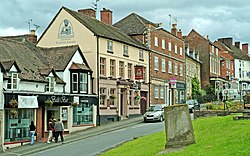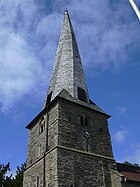Cleobury Mortimer
| Cleobury Mortimer | |
| Shropshire | |
|---|---|
 Cleobury Mortimer | |
| Location | |
| Grid reference: | SO675758 |
| Location: | 52°22’43"N, 2°28’56"W |
| Data | |
| Population: | 1,962 |
| Post town: | Kidderminster |
| Postcode: | DY14 |
| Dialling code: | 01299 |
| Local Government | |
| Council: | Shropshire |
| Parliamentary constituency: |
Ludlow |
Cleobury Mortimer is a small rural market town in Shropshire. It is reckoned the third smallest town in Shropshire (after Clun and Bishop's Castle), and calls itself a town by virtue of a town charter granted in 1253.[1]
Contents
Name of the town
The name is believed to derive from the contraction of the Old English clifu meaning a steep place and burg meaning fortified settlement. Mortimer comes from Roger de Mortimer of Normandy to whom the land was granted after the Norman conquest. He founded the Mortimer dynasty of Marcher Lords who held power in the Welsh Marches
Several pronunciations of the town's name are in use. In Cleobury itself "Clib-bree" is commonly used, while in surrounding areas such variations as "Cleb-bree" and "Clee-bree" are used
History
Roger de Mortimer came from Normandy with William the Conqueror and received land in Shropshire. He founded the Mortimer dynasty and were closely involved with power struggles with successive kings and other powerful nobles. Cleobury Mortimer takes the latter part of its name from the Mortimers, the local magnates. Cleobury has a significant entry in the Domesday Book, and is the site of at least two castles. Cleobury Castle was destroyed in 1155 and only earthworks remain today.
The central section of the town was laid out in burgage plots, the lines of which are still evident. With the defeat of the last Welsh princes, there was peace along the Welsh border and Cleobury's importance declined during the Middle Ages, leaving it as an undistinguished market town, with a long history, a market, and a dependent hinterland.
In the 16th century, exploitation of local iron ores became important, and when Elizabeth I granted the town to Robert Dudley, Earl of Leicester, his familiarity with modern ironworking technology led to the establishment of an important iron industry, with at least two furnaces (in which iron ore was converted to pig iron) and two water-powered forges (in which pig iron was converted to wrought iron). For a while, Cleobury's iron industry was an important part of the general industrialisation in Shropshire, one of the early seats of the Industrial Revolution. Iron from Cleobury's forges was valued as a high-quality material. However, poor transport connections led to the decline of Cleobury's iron industry in the early 19th century, and soon the town reverted to being an agricultural hub, although a large water-powered paper mill survived on the River Rea until a catastrophic fire towards the end of the century.
By 1900, the town was an important civic centre, with a railway station, union workhouse, magistrates' court, police station, Agricultural College, Infants' School and Primary School. Since the start of the twentieth century, Cleobury lost many of these facilities, although its population has grown. It thus exemplifies a common pattern for rural settlements, where centralisation and the rise of road transport have seen a decline in the local provision of services, despite a rising population.
Literature
Two literary figures have strong connections with Cleobury: William Langland and Simon Evans.
Langland, a contemporary of Geoffrey Chaucer, was almost certainly born in the vicinity in the 14th century. He is known for one work; The Dream of Piers Plowman, one of the greatest of works in Middle English. Langland is commemorated in the very fine and intricate (Victorian) East Window of St Mary's Church, as well as in a local road name.
Simon Evans is a 20th-century writer, who fought throughout the First World War, and suffered from being gassed. He had been a postman on Merseyside before the war, and after the war sought a rural postal round, to soothe both nerves and body. Cleobury suited him well; here he blossomed, took a correspondence course in English, and became a successful writer and radio broadcaster in the 1930s. Heath Cranton published five of his books, and he married 'Auntie Doris' (Aldridge), a radio performer, but his new life was cut short in 1940, when the effects of WWI gassing finally caught up with him. His legacy is visible in the naming of a local street, a plaque on the old Post Office, and a dedicated local walk - 'The Simon Evans Way' - which the CM Footpath Association has created in recent years.
Geography
The River Rea runs to the east of the town. The land gradually rises from 300 feet above sea level near to the river, to some 500 feet in the west of the town. The Clee Hills, the highest hills in Shropshire, are nearby and the Wyre Forest lies between the town and Bewdley. The border with Worcestershire is a mile to the south.
The A4117 Kidderminster to Ludlow road runs through the centre of the town and crosses the River Rea at Mortimer Bridge. The B4363 runs between Cleobury Mortimer (its junction with the A4117 being immediately east of Mortimer Bridge) and Bridgnorth.
Cleobury Mortimer was formerly served by two railways: the Tenbury & Bewdley Railway and the Cleobury Mortimer and Ditton Priors Light Railway. The opening of the latter in 1908 elevated Cleobury's station to the status of a 'Junction'. Today the nearest railway stations are at Highley and Bewdley on the Severn Valley Railway, with mainline trains at Ludlow and Kidderminster.
To the north lies the village of Neen Savage and to the southwest lies the small village of Neen Sollars. "Neen" was the name of the River Rea in the past.
Sights of the town
The most famous sight of Cleobury Mortimer is the 12th-century St Mary's Church[2] in the town centre, renowned for its crooked spire, the combined result of the warping of its oak timbers, and damp-induced rot where the timber spire sits on the masonry tower.
Across the road from the churchyard is The Wells, fed from a local spring and for centuries serving as a public water supply. In 2010, for reasons as yet unexplained, the inflow to The Wells ceased, and the tank remains dry. To the west of the church is the recently refurbished Market Hall, which now houses a number of facilities including the Tourist Information Centre. There are 8 public houses in Cleobury Mortimer, as well as a secondary school and primary school, library, fire station, and police station.
Brewery
Hobsons brewery was established in 1993 and moved to its present site at New House Farm, on Tenbury Road approximately 500 yards southeast of the town centre, in 1995. The brewery brews and delivers its beer to public houses within a 50-mile radius, as well as bottle-conditioned ale to shops in the area, and throughout the United Kingdom. Its regular mild, best bitter and strong bitter ("Old Henry") ales have won taste awards in recent years, and the mild was chosen to be a guest beer in the House of Commons bar in 2008. Hobsons produce a bottle-only mild ale, named in honour of Simon Evans, called "Postman's Knock".
In 2009 the brewery installed a small wind turbine, which generates around a third of the electricity required by the brewery, and the company use other environmentally sustainable technologies. The King's Arms in the town became the "brewery tap" in 2007 and was the first pub to receive a delivery of Hobsons beer in 1993. Hobsons also produce two special beers for the local heritage railway, the Severn Valley Railway.[3][4][5]
References
- ↑ "Street". Cleobury Country. http://kiosk.cleoburycountry.com/streetintro.html. Retrieved 2008-01-19.
- ↑ Cleobury Benefice website
- ↑ Campaign for Real Ale Good Beer Guide 2010, pages 396 & 749
- ↑ King's Arms company website
- ↑ Hobsons company website

